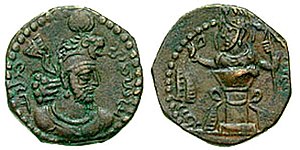This is an old revision of this page, as edited by HistoryofIran (talk | contribs) at 22:26, 7 April 2019 (removing cng as its not a reliable source). The present address (URL) is a permanent link to this revision, which may differ significantly from the current revision.
Revision as of 22:26, 7 April 2019 by HistoryofIran (talk | contribs) (removing cng as its not a reliable source)(diff) ← Previous revision | Latest revision (diff) | Newer revision → (diff) For the Sasanian Emperor, see Hormizd I.




Hormizd I Kushanshah (277-286 CE), also Ohrmazd I, was a Kushano-Sasanids Kushanshas ruler, in effect a governor of the Sassanid Empire for the eastern regions of Sogdiana, Bactria and Gandhara which had been captured following the fall of the Kushans in 225 CE. His coins were minted at Kabul, Balkh, Herat, and Merv.
He was probably a son of Sasanian king Bahram I and brother of Bahram II.
He issued coins with the title Kushanshahanshah ("King of kings of the Kushans"), probably in defiance of imperial Sasanian rule. Some of his coins imitate Kushan coinage, with king standing in Kushan military dress on the obverse, and deity Oēšo (Shiva) on the reverse. Other coins however follow more closely the Sasanian pattern, with a king being portrayed in the Sasanian style, and with fire altar or deity on the reverse.

Hormizd I Kushanshah seems to have led a rebellion against contemporary emperor Bahram II (276-293 CE) of the Sasanian Empire, but failed. According to the Panegyrici Latini (3rd-4th century CE), there was a rebellion of a certain Ormis (Ormisdas) against his brother Bahram II, and Ormis was supported by the people of Saccis (Sakastan). Hormizd of Sakastan may or may not be identical with him.
References
- ^ The Cambridge History of Iran, Volume 3, E. Yarshater p.209 sq
- ^ Shahbazi 2004.
Sources
- Daryaee, Touraj (2014). Sasanian Persia: The Rise and Fall of an Empire. I.B.Tauris. pp. 1–240. ISBN 0857716662.
{{cite book}}: Invalid|ref=harv(help) - Potter, David (2013). Constantine the Emperor. Oxford University Press. ISBN 978-0199755868.
{{cite book}}: Invalid|ref=harv(help) - Frye, Richard Nelson (1984). The History of Ancient Iran. C.H.Beck. pp. 1–411. ISBN 9783406093975.
{{cite book}}: Invalid|ref=harv(help) - Shahbazi, A. Shapur (1988). "Bahrām II". Encyclopaedia Iranica, Vol. III, Fasc. 5. pp. 514–522.
{{cite encyclopedia}}: Invalid|ref=harv(help) - Frye, R. N. (1983), "Chapter 4", The political history of Iran under the Sasanians, The Cambridge History of Iran, vol. 3, Cambridge University Press, ISBN 978-0-521-20092-9
{{citation}}: Invalid|ref=harv(help) - Shahbazi, A. Shapur (2004). Hormozd Kusansah.
{{cite book}}: Invalid|ref=harv(help); Unknown parameter|encyclopedia=ignored (help) - Rezakhani, Khodadad (2017). ReOrienting the Sasanians: East Iran in Late Antiquity. Edinburgh University Press. pp. 1–256. ISBN 9781474400305.
{{cite book}}: Invalid|ref=harv(help)
| Preceded byPeroz I Kushanshah | Kushanshah of the Kushano-Sasanian Kingdom 277-286 |
Succeeded byHormizd II Kushanshah |